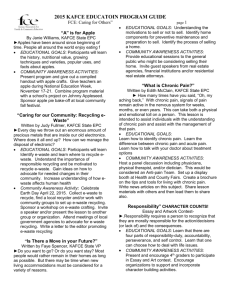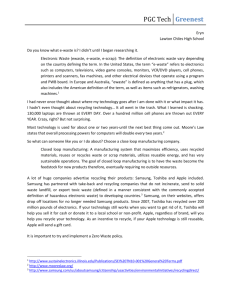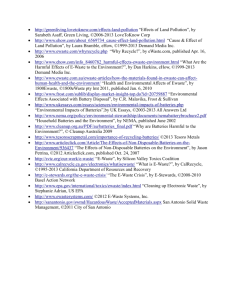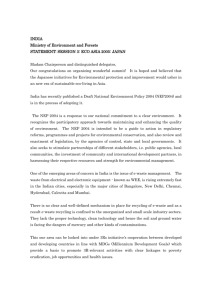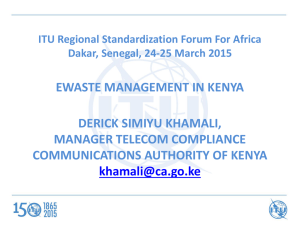Online Food Ordering System
advertisement
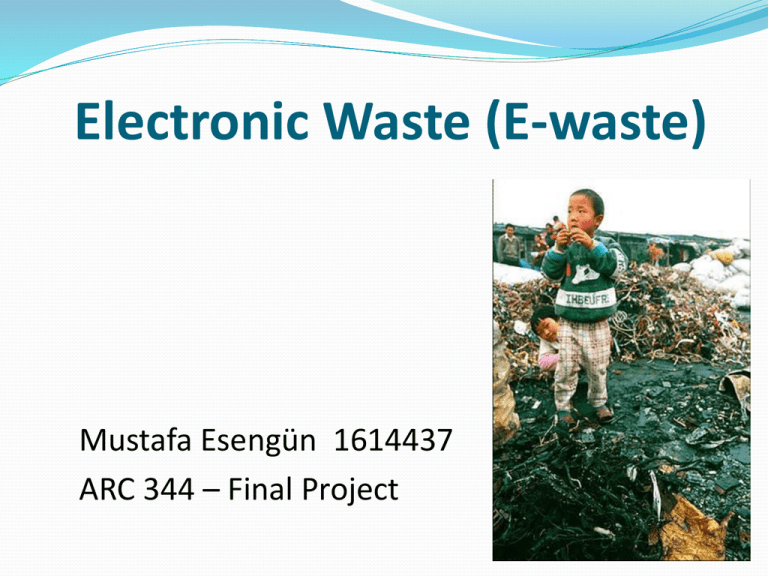
Electronic Waste (E-waste) Mustafa Esengün 1614437 ARC 344 – Final Project Outline Research Progress What is E-waste? Dangerous of E-waste Facts about E-waste Possible Solutions Toxic Trade Conclusion Research Progress Definition of e-waste The causes and the effects of e-waste Possible solutions to the e-waste Leading organizations EPA (United States Environmental Protection Agency) UNEP (United Nations Environment Programme) Recycling Charity Donations European Union Parliment and of the Council Policies of Apple, Microsoft, Dell, Nokia What is E-waste? Electronic Waste: Any type of electronic device that is no longer operational or not in use is called electronic waste. Main characteristics of ewaste: Includes toxic components No longer operational or thrown away Hard to recycle US Environmental Protection Agency (EPA)’s definition: “E-waste”, “electronic waste”, “e-scrap” and “end-of-life electronics” are terms often used to describe used electronics that are nearing the end of their useful life, and are discarded, donated or given to a recycler. Dangerous Effects of E-waste Affects environment and humans heatlh Common elements in ewastes: Cadmium Lead Mercury Nickel Antimony Beryllium Arsenic Barium Dangerous Effects of E-waste(cont.) Cadmium: Kidney damage, lung cancer. Used in soldering semiconductors and chip resistors. Lead: Attackts to nervous system, blood anemia, brain damage. Used in soldering the circuit boards. Mercury: Lung damage, eye & skin irritation, nausea. Used in light-bulbs. Nickel: Skin damages, asthma carcinogen. Spread through the air. Dangerous Effects of E-waste(cont.) Antimony: Eye & skin irritation, hair loss heart damages. Beryllium: Chronic lung disorder, not dissolve in water. Used in portions of electrical connectors and battery contacts. Arsenic: Skin & lung cancer. Used in integrated circuits and semiconductors. Barium: Muscle weakness, change in heart beat rate. Facts about E-waste UNEP – Resources from Ewaste to Resources, February 2010 released EU 9.3 million tons of electronic devices in 2005 released USA 34 millions tvs and display screens Survey results of Nokia in 2008 (13 countries, 6500 people) Average of 5 used cell phones for each person Only the 3% of participants recycled the their old phones. Solutions to E-waste People’s Awareness Recycling Charity Donations Recycling Policies People’s Awareness More action instead of creating research pool Donate our old working devices to the poor people Repairing the broken devices instead of buying a new one Buying environment friendly products (recyclable? Microsoft wireless mouses can be recycled 10 times) Using our devices to their complete life period Recycling Charity Donations Giving away unusable products to recycling charity donations Simple process for recycling Examples: In USA Computer Reach organization collects the old Apple computers, repairs them and uses them to improve others lives. Ozdenizcilik Inc. recycles the unusable electronic cables Recycling High effectiveness, the most expensive method Needs automated and well equipped facilities (expensive) Process: Companies take-back policies or Governments actions collect the non operational electronic products If companies have a recycling center, they subtract the reusable parts. Otherwise, Companies ship those products to the developing countries and make them subtract the pieces (cheaper) Uganda Recycling Project Unido, Microsoft, EMPA, a Swiss-based research institute, the Uganda National Cleaner Production Centre and the Ugandan Government lead the project. Project aims: To investigate the current ewaste landscape status in Uganda To prepare a waste management system in terms of providing economically and environmently contribution Goodwill Industires Initiative Combines Dell and Microsoft Those companies collect their old products and dispose them properly instead of shipping them Thanks to this program, 96 million pounds of ewaste, that could possibly end up in landfills, is saved. European Union Action EU policies requires companies to have take-back policies in order to do business in Europe. Apple’s Action Steve Jobs former CEO o Apple claims that Apple recycled 13 million pounds of e-waste in 2006 Apple recycled 28% of past sales of Apple Toxic Trade Recycling is too expensive. Developed countires(USA,EU) Ships their products Developing Countries Recycling a computer costs about 20$ in USA and Europe, while same operation costs only 2$ in India. Toxic Trade Developed countries claim that They improve employment in those countries Recyclers in developing countries are exposed to toxic materials. Non-recycable parts stays in the developing countries landfills, which causes environmental pollution. Developing countries have to burn out the landfills for the following waste, which causes air pollution. Toxic Trade Ewaste growth in India: Conclusion E-waste murders generations, and our environment. The countries responsible for that need to be highlighted to attract global attention References What is Ewaste: http://www.epa.gov/international/toxics/ewaste/index.html Dangers of Ewaste: http://www.ewaste.com.au/ewaste-articles Ewaste Facts: http://www.greenchiprecycling.com/images/problemComputer.p ng http://press.nokia.com/2008/07/08/ Solutions to Ewaste http://www.businessdailyafrica.com/Corporate-News http://venturebeat.com/2010/04/22/ http://www.apple.com/hotnews/agreenerapple/ Toxic Trade http://sitemaker.umich.edu/section002group3/e-waste http://www.toxicslink.org/im-info/art_134_3.jpg
